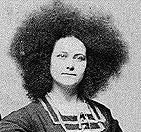The Circassian Beauty ExhibitThe Lost Museum Archive

Zalumma Agra, "Star of the East," was (at least according to Barnum) rescued from the slave markets of Constantinople. She was said to be the daughter of a prince from the mountainous region of the Black Sea--the purported birthplace of the Caucasian race. As the "purest" type of white person, Circassian women were said to be the most beautiful on earth, prized by Turkish sultans for their harems. Surprisingly proficient in English, and mysteriously deficient in her knowledge of "Circassia," Zalumma Agra was nonetheless a highly popular attraction at the American Museum. "Circassian Beauties" became a mainstay of dime museums and side shows until the end of the nineteenth century, attracting white audiences fascinated by the "exotic East" and preoccupied by issues of race.